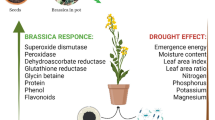Abstract
In modern conventional agriculture, herbicides are frequently used to prevent yield losses due to weeds. Herbicides also affect negatively the productivity of legumes. With these considerations, we evaluated the effects of soil applications of different concentrations of quizalafop-p-ethyl and clodinafop on the performance of Rhizobium inoculated pea, grown in clay pots. In this study, the concentration of herbicides higher than the recommended rates of quizalafop-p-ethyl and clodinafop adversely affected the dry matter accumulation, symbiotic properties, grain yield and nutrient status of pea plants. Toxicity of quizalafop-p-ethyl and clodinafop to pea plants increased progressively with increase in rates of herbicides. Of the two herbicides, quizalafop-p-ethyl was more toxic than clodinafop. In contrast, when herbicide tolerant Rhizobium strain MRP1 was also used with herbicide, it increased the measured parameters at all concentrations. A maximum increase of 11%, 17%, 46%, 33%, 21% and 7% in the root N, shoot N, root P, shoot P, seed yield and seed protein, respectively, was observed when MRP1 was used with 120 μg quizalafop-p-ethyl kg−1 soil while with 1,200 μg clodinafop kg−1 soil it increased the root N, shoot N, root P, shoot P, seed yield and seed protein by 20%, 9%, 56%, 56%, 29% and 7%, respectively, compared with the un-inoculated but herbicide treated control. This study suggested that the toxic effects of herbicides on pea plants could be attenuated by applying growth promoting herbicide tolerant strain of Rhizobium under herbicide stressed soil environment.
Similar content being viewed by others
References
Aamil M, Zaidi A, Khan MS (2004) Effects of herbicide dose rate on nodule bacteria and growth, nodulation and yield of chickpea (Cicer arietinum L.). Ann Pl Protec Sci 12:186–191
Abbate V, Avola G, Tuttobene R, Barbera A (2001) Valutazione di variata di fava, cece, pisello proteico, lenticchia e cicerchia, Inf. Agrar 39:67–75
Ahlawat IPS (2000) Pea. In: Rathore PS (ed) Technique and management of filed crop production. Agrobios Publications, New Delhi
Alexander DB, Zuberer DA (1991) Use of chrome azurol S reagents to evaluate siderophore production by rhizosphere bacteria. Biol Fert Soils 12:39-45 doi: 10.1007/BF00369386
Avola G, Gresta F, Patane C, Abbate V (2004) Chemical weeds control and sowing depth in grain legumes. In Proceedings of the VIII International Congress of European Society of Agronomy, Copenhagen, Denmark, 571–572
Brick JM, Bostock RM, Silversone SE (1991) Rapid in situ assay for indole acetic acid production by bacteria immobilized on nitrocellulose membrane. Appl Environ Microbiol 57:535–538
Fox JE, Gulledge J, Engelhaupt E, Burow ME, McLachlan JA (2007) Pesticides reduce symbiotic efficiency of nitrogen-fixing rhizobia and host plants. PNAS 104:10282–10287. doi:10.1073/pnas.0611710104
Gordon S, Weber RP (1951) The colorimetric estimation of IAA. Plant Physiol 26:192–195
Iswaran V, Marwah TS (1980) A modified rapid Kjeldahl method for determination of total nitrogen in agricultural and biological materials. Geobios 7:281–282
Jackson ML (1967) Soil chemical analysis. Prentice-Hall of India, New Delhi, pp 134–144
Javier Benitez F, Real FJ, Acero JL, Garcia C (2006) Photochemical oxidation processes for the elimination of phenyl-urea herbicides in waters. J Hazard Mater B 138:278–287. doi:10.1016/j.jhazmat.2006.05.077
Khan MS, Aamil M, Zaidi A (2004) Influence of herbicides on Chickpea-Mesorhizobium symbiosis. Agronomie 24:123–127. doi:10.1051/agro:2004009
Khan MS, Chaudhry P, Wani PA, Zaidi A (2006a) Biotoxic effects of the herbicides on growth, seed yield, and grain protein of greengram. J Appl Sci Environ Mgt 10:141–146
Khan MS, Zaidi A, Rizvi PQ (2006b) Biotoxic effects of herbicides on growth, nodulation, nitrogenase activity, and seed production in chickpeas. Commu Soil Sci Pl Anal 37:1783–1793. doi:10.1080/00103620600710645
Kucey RMN, Chaiwanakupt P, Arayangkool T, Snitwongse P, Siripaibool C, Wadisirisuk P, Boonkerd N (1988) Effect of herbicides and water application schedule. Plant Soil 108:87–92. doi:10.1007/BF02370103
Mody BR, Bindra MO, Modi VV (1989) Extracellular polysaccharides of cowpea rhizobia: compositional and functional studies. Arch Microbiol 1:2–5
Niewiadomska A, Klama J (2005) Pesticide side effect on the symbiotic efficiency and nitrogenase activity of Rhizobiaceae bacteria family. Pol J Microbiol 54:43–48
Nomal SS (2006) Allelopathy in ecological sustainable agriculture. In: Reigosa MJ, Pedrol N, Gonzalez L (eds) Allelopathy: a phsiological processes with ecological implications. Springer, Dordrecht, pp 537–564
Reeves MW, Pine L, Neilands JB, Balows A (1983) Absence of siderophore activity in Legionella species grown in iron-deficient media. J Bacteriol 154:324–329
Sadasivam S, Manikam A (1992) Biochemical methods for agricultural sciences. Wiley Eastern Limited, New Delhi
Santos JB, Ferreira EA, Kasuya MCM, Silva AA, Procopio SO (2005) Tolerance of Bradyrhizobium strains to glyphosate formulations. Crop Prot 24:543–547. doi:10.1016/j.cropro.2004.10.007
Sawicka A, Selwet M (1998) Effect of active ingredients on Rhizobium and Bradyrhizobium Legume dinitrogen fixation. Pol J Environ Studies 7:317–320
Singh G, Wright D (2002a) In vitro studies on the effects of herbicides on the growth of rhizobia. Lett Appl Microbiol 35:12–16. doi:10.1046/j.1472-765X.2002.01117.x
Singh G, Wright D (2002b) Effects of herbicides on nodulation and growth of two varieties of peas (Pisum sativum). Acta Agronom Hung 50:337–348. doi:10.1556/AAgr.50.2002.3.11
Wall DA (1996) Lentil (Lens culineris) and faba bean (Vicia faba) tolerance to post emergence application of imazethapyr. Can J Plant Sci 76:525–529
Wani PA, Khan MS, Zaidi A (2008) Effect of metal-tolerant plant growth-promoting Rhizobium on the performance of pea grown in metal-amended soil. Arch Environ Contam Toxicol. doi 10.1007/s00244-007-9097-y
Yang C, Lee C (2008) Enrichment, isolation, and characterization of 4-chlorophenol-degrading bacterium Rhizobium sp. 4-CP-20. Biodegradation 19:329–336
Zablotowicz RM, Reddy KN (2004) Impact of glyphosate on the Bradyrhizobium japonicum symbiosis with glyphosate-resistant transgenic soybean: a minireview. J Environ Qual 33:825–831
Zawoznik MS, Tomaro ML (2005) Effect of chlorimuron-ethyl on Bradyrhizobium japonicum and its symbiosis with soybean. Pest Manage Sci 61:1003–1008. doi:10.1002/ps.1077
Acknowledgments
We are grateful to Dr. Naqvi, Parijat Agrochemicals, New Delhi, India, for providing technical grade herbicides.
Author information
Authors and Affiliations
Corresponding author
Rights and permissions
About this article
Cite this article
Ahemad, M., Khan, M.S. Toxicity Assessment of Herbicides Quizalafop-p-Ethyl and Clodinafop Towards Rhizobium Pea Symbiosis. Bull Environ Contam Toxicol 82, 761–766 (2009). https://doi.org/10.1007/s00128-009-9692-x
Received:
Accepted:
Published:
Issue Date:
DOI: https://doi.org/10.1007/s00128-009-9692-x




